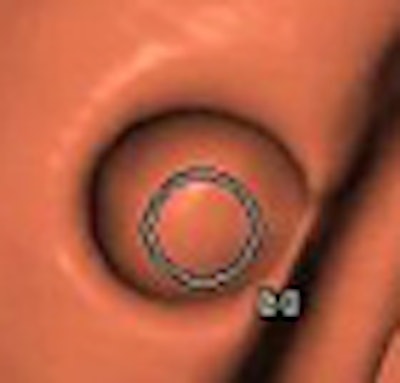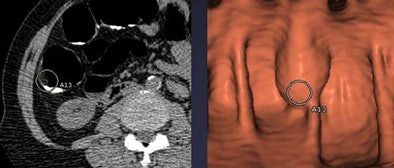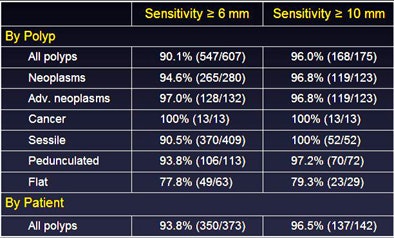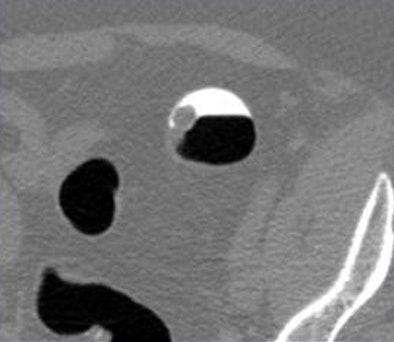
RESTON, VA - The largest trial to date using computer-aided detection (CAD) to analyze virtual colonoscopy images indicates that CAD can find polyps that a panel of expert readers missed in asymptomatic subjects, according to a presentation at this week's International Symposium on Virtual Colonoscopy.
"CAD is a really promising tool for CTC [CT colonography] interpretation, but we felt that in general there has been relatively little data looking at a really large, robust screening cohort that was using experienced readers, primary 3D interpretation, and oral contrast," said Edward Lawrence, a medical student from Albert Einstein College of Medicine in New York City.
Most CAD research to date has focused on symptomatic cohorts, less experienced readers, and primary 2D interpretation without contrast.
The study, conducted at the University of Wisconsin in Madison, sought to evaluate a standalone CAD system (ColonCAD 4.0, Medicsight, London) for detecting colorectal polyps 6 mm or larger. The CAD software is commercially available internationally but not yet approved by the U.S. Food and Drug Administration (FDA). (An early version of the product, ColonCAR 1.2.1, was approved by the agency in 2004.)
The retrospective study by Lawrence and colleagues Dr. Perry Pickhardt, Dr. David Kim, and Dr. Jessica Robbins examined 3,077 consecutive asymptomatic adults (1,655 women, 1,422 men; mean age, 56.9 years), Lawrence said. Patients were derived from the University of Wisconsin screening cohort from March 2006 to December 2008.
 |
| Above, a false-positive CAD mark highlights a submucosal lipoma. All images courtesy of Dr. Perry Pickhardt. |
All subjects received a low-volume saline-based cathartic bowel preparation (magnesium citrate or sodium phosphate), in addition to a 2% barium suspension and MD-Gastroview (Covidien, Dublin, Ireland) iodinated oral contrast for fecal and fluid tagging. No electronic cleansing was used.
After automated insufflation of the colon with CO2 (ProtoCO2l, Bracco Diagnostics, Princeton, NJ), the subjects were scanned prone and supine (some in the decubitus position) on a 64-detector-row CT scanner (GE Healthcare, Chalfont St. Giles, U.K.) using 1.25-mm collimation, 1-mm reconstruction interval, and 120 kVp with a static or modulated low-mAs technique.
Considering that some University of Wisconsin screening subjects elect polyp surveillance for small lesions, the reference standard or ground truth for polyps consisted of expert radiologist interpretation with subsequent colonoscopy confirmation and/or retrospective expert reader polyp localization at VC. The CAD test set was kept separate from the CAD training data, Lawrence explained.
After the initial primary 3D read on the Viatronix (Stony Brook, NY) workstation, supplemented by 2D confirmation, relevant details of all polyps 6 mm or larger were recorded, he said.
"Then we went back and looked at the colonoscopy results if they were available, we did retrospective CT confirmation for the polyps, and then as some of these people went into surveillance, we used the follow-up results from the surveillance studies to make sure the follow-ups we were looking at were true polyps," Lawrence said.
Another subset consisted of polyps 6 mm or larger that had been found at optical colonoscopy but missed in the expert read, which constituted a CTC false-negative group that allowed the researchers to assess any additional benefit from CAD.
The ground truth assessment found a wide variety of lesions for analysis:
- 607 polyps ≥ 6 mm (373 individuals)
- 175 polyps ≥ 10 mm (142 individuals)
- 280 total neoplasms
- 132 advanced neoplasms
- 13 cancers
- Morphology: 409 sessile, 113 pedunculated
In the detection of these lesions, the per-patient CAD sensitivity was 93.8% (350/373) and 96.5% (137/142) for lesions ≥ 6 mm and 10 mm, respectively, Lawrence reported. The per-polyp CAD sensitivity for all polyps regardless of histology was 90.1% (547/607) and 96% (168/175) at the 6-mm and 10-mm thresholds, respectively.
 |
| CAD detection results show high sensitivity across polyp sizes and most morphology types; only flat lesion sensitivities dropped below 80%. |
CAD also performed well for the most clinically relevant findings: the software found 97% of the advanced neoplasms and all 13 cancers, Lawrence said. The only statistically significant difference in detection rates was the drop between sensitivity for pedunculated lesions at greater than 90% versus flat polyps (< 3 mm in height) at still-impressive 77% and 79% sensitivities for the 6-mm and 10-mm thresholds, respectively, he said.
Among the 373 patients with a positive result, "we found this CAD system was able to detect an additional 15 polyps ≥ 6 mm, including four polyps ≥ 10 mm which had been missed by the expert human panel -- so these are catches that in the daily life of the University of Wisconsin screening program were missed," Lawrence said.
Polyps submerged in fluid represented the largest group of CAD misses (n = 133, 33.1% of all misses), but that number included polyps partially or fully submerged in either prone or supine view. Only 60 polyps were missed by CAD on both views. Another 107 polyps (26.6% of all misses) were missed for no identifiable reason, followed by 55 (13.7% of all misses) with flat morphology and 41 (10.2% of all misses) located on or near a fold. Twenty-four contrast-coated polyps were missed by CAD.
 |
| CAD missed a pedunculated polyp that was submerged in fluid in prone view (above) but detected it in both 2D and 3D when the fluid was cleared in supine view. |
 |
There were a mean 4.7 false positives with a median of three per case -- a very reasonable rate for clinical use, Lawrence said.
Top causes of false-positives
|
||||||||||||||
"This CAD method showed robust performance for polyp detection in the screening setting," Lawrence said. "It had high sensitivity both for relevant polyps and cancers, and it had an acceptable false-positive rate of fewer than five per case, so it's not going to slow down the radiologists significantly."
Its incremental value was also noteworthy. CAD found 15 additional polyps, including four large polyps that had been missed by the expert readers, Lawrence said.
There is room for improvement in the CAD algorithm, especially with regard to reducing CAD hits on tagged stool, he said.
"Because it's such a robust asymptomatic patient population, these results really support the idea that CAD systems are ready to go in the clinical setting, especially as a second reader," Lawrence said.
By Eric Barnes
AuntMinnie.com staff writer
October 29, 2009
Related Reading
VC researchers weigh 3 iodine tagging regimens, September 21, 2009
Readers undaunted by VC CAD false positives, June 12, 2009
VC CAD plus 3D improves sensitivity for novice readers, April 21, 2009
VC CAD plus electronic cleaning boosts sensitivity, false positives, April 10, 2009
VC CAD finds polyps in prepped or unprepped patients, May 6, 2008
Copyright © 2009 AuntMinnie.com




















